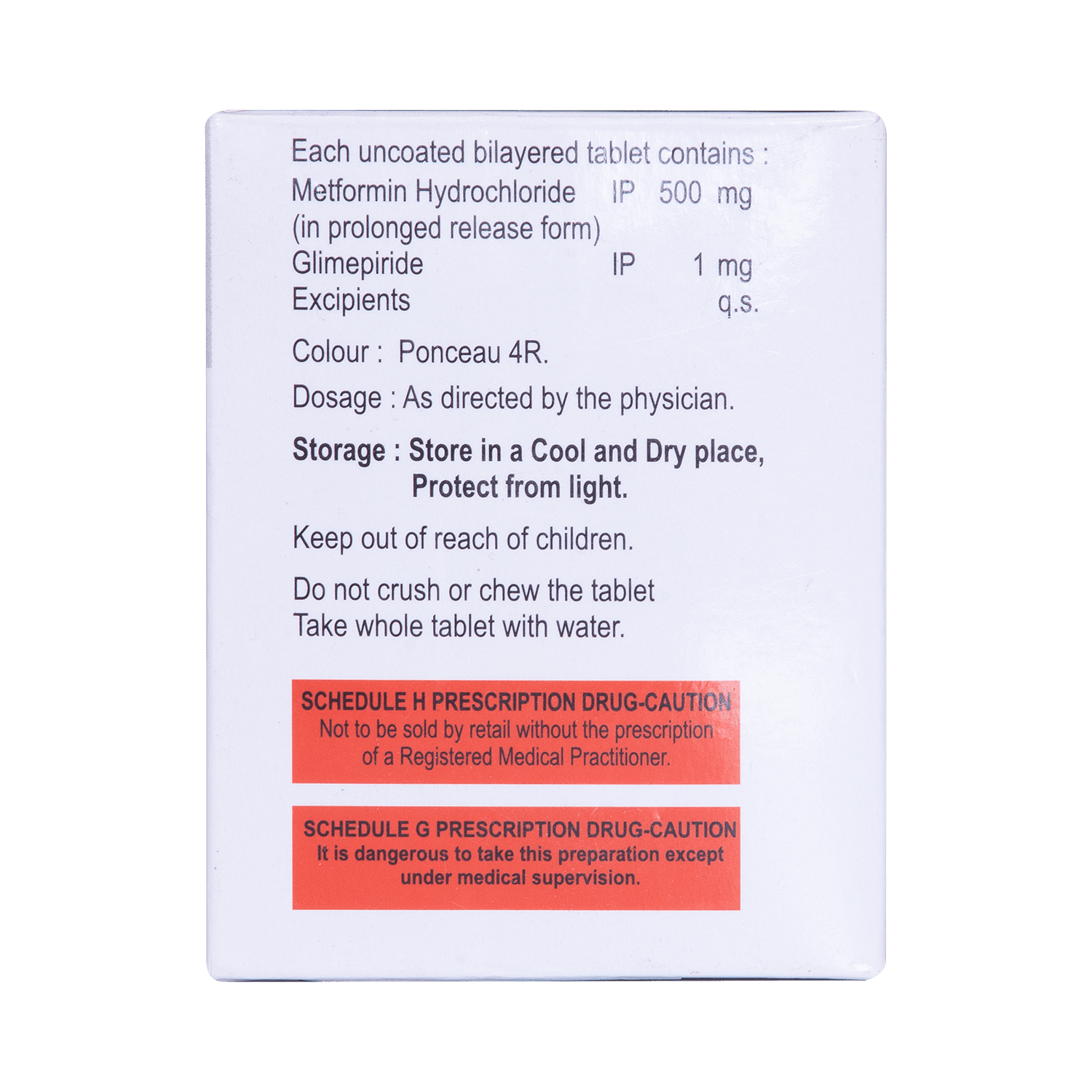
Diaprid-M 1mg/500mg Tablet
Manufacturer
Uniroyal Biotech
Salt Composition
Glimepiride (1mg) + Metformin (500mg)
Key Information
Short Description
Diaprid-M 1mg/500mg Tablet is a combination of two medicines used to treat type 2 diabetes mellitus in adults. It helps control blood sugar levels in people with diabetes.
Dosage Form
Tablet
Introduction
Diaprid-M 1mg/500mg Tablet belongs to a category of medicines known as anti-diabetic drugs. It is a combination of two medicines used to treat type 2 diabetes mellitus in adults. It helps control blood sugar levels in people with diabetes.
Directions for Use
Take this medicine in the dose and duration as advised by your doctor. Swallow it as a whole. Do not chew, crush or break it. Diaprid-M 1mg/500mg Tablet is to be taken with food.
How it works
Diaprid-M 1mg/500mg Tablet is a combination of two antidiabetic medicines: Glimepiride and Metformin. Glimepiride is a sulfonylurea which works by increasing the amount of insulin released by the pancreas in order to lower the blood glucose. Metformin is a biguanide which works by lowering glucose production in the liver, delaying glucose absorption from intestines and increasing the body's sensitivity to insulin.
Quick Tips
Take it with food to lower your chance of having an upset stomach. Monitor your blood sugar level regularly while you are taking this medicine. It can cause hypoglycemia (low blood sugar level) when used with other antidiabetic medicines, alcohol or if you delay or miss a meal. Inform your doctor about your diabetes treatment if you are due to have surgery under a general anesthetic. Tell your doctor immediately if you experience any deep or rapid breathing or if you have persistent nausea, vomiting and stomach pain as Diaprid-M 1mg/500mg Tablet may cause a rare but serious condition called lactic acidosis which is an excess of lactic acid in the blood.
Related Medicines

Metffil G1 Tablet

Glimfirst M1 Tablet

Glimp-M 1 Tablet

Glimcloud-M 1 Tablet

Meprimet M 1mg/500mg Tablet

Accuglim M 1mg/500mg Tablet

Glycifit G 1 Tablet

Lyglim-MF 1mg/500mg Tablet

Glinorm M 1mg/500mg Tablet

Metshine Tablet
Frequently asked questions
What are the recommended storage conditions for Diaprid-M 1mg/500mg Tablet?
Store Diaprid-M 1mg/500mg Tablet in its original container, tightly closed, and according to the instructions on the pack or label. Dispose of unused medicine properly, ensuring it is not accessible to pets, children, or other individuals.
Can the use of Diaprid-M 1mg/500mg Tablet lead to lactic acidosis?
Yes, using Diaprid-M 1mg/500mg Tablet may cause lactic acidosis, a medical emergency resulting from elevated blood lactate levels. This rare side effect is associated with kidney disease, advanced age, or excessive alcohol consumption. Symptoms include muscle pain or weakness, dizziness, tiredness, cold extremities, breathing difficulties, nausea, vomiting, abdominal pain, or slow heart rate. If you experience these symptoms, discontinue use and consult your doctor immediately.
What is Diaprid-M 1mg/500mg Tablet?
Diaprid-M 1mg/500mg Tablet is a combination of Glimepiride and Metformin. This medication is used to treat type 2 diabetes mellitus (DM) in adults, improving blood glucose levels when taken alongside a proper diet and regular exercise. It is not indicated for the treatment of type 1 DM.
What are the possible side effects of Diaprid-M 1mg/500mg Tablet?
Common side effects associated with the use of Diaprid-M 1mg/500mg Tablet include hypoglycemia (low blood sugar), altered taste, nausea, stomach pain, diarrhea, and headache. Rare but serious side effects may include lactic acidosis. Long-term use can also lead to Vitamin B12 deficiency.
Can the use of Diaprid-M 1mg/500mg Tablet cause Vitamin B12 deficiency?
Yes, prolonged use of Diaprid-M 1mg/500mg Tablet may result in Vitamin B12 deficiency. This is due to interference with stomach absorption, potentially leading to anemia and nerve problems if left untreated. These issues can manifest as tingling sensations or numbness in hands and feet, weakness, urinary difficulties, changes in mental status, and balance problems (ataxia). To avoid these complications, consider supplementing with Vitamin B12 at least annually.
Can the use of Diaprid-M 1mg/500mg Tablet cause hypoglycemia?
Yes, using Diaprid-M 1mg/500mg Tablet can lead to hypoglycemia. Symptoms include nausea, headache, irritability, hunger, sweating, dizziness, fast heart rate, and feeling anxious or shaky. Hypoglycemia is more likely if you miss meals, drink alcohol, over-exercise, or take other antidiabetic medications alongside Diaprid-M 1mg/500mg Tablet. Regular blood sugar monitoring is crucial. Keep a quick source of sugar handy.
Is it safe to take alcohol while I am also taking Diaprid-M 1mg/500mg Tablet?
No, consuming alcohol while using Diaprid-M 1mg/500mg Tablet is not recommended, as it can lower your blood sugar levels and increase the risk of hypoglycemia. It may also raise the chances of lactic acidosis.


